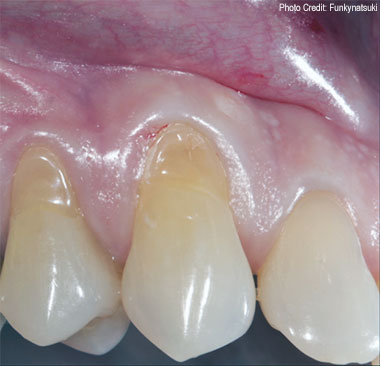
Photo credit: Funkynatsuki
Toothbrush abrasion is a wearing down of the enamel (the outer layer of the tooth) and sometimes the subsequent recession of the gum tissue in the same area. Toothbrush abrasion typically occurs on the outer surfaces of the teeth that are easier to access with the toothbrush but can occur anywhere in the mouth. Toothbrush abrasion can be localized to a single tooth or generalized to several teeth.
What Causes Toothbrush Abrasion?
- Brushing aggressively and with too much pressure over some time on the tooth and gum surfaces
- Using a toothbrush that is too firm, such as a medium or hard-bristled manual toothbrush
- Using an incorrect brushing technique with an electric toothbrush
Signs and Symptoms of Toothbrush Abrasion
- Tooth sensitivity, typically sensitivity to cold temperatures
- Worn down or indented notches on the sides of the teeth
- Yellow discolouration of the teeth at the gum line
- Gum recession
Prevention of Toothbrush Abrasion
Make sure to use the correct brushing technique while brushing your teeth. If you use a manual toothbrush, use a vibrating stroke and sweep the toothbrush away from your gums, never side to side or up and down. Never use a medium or hard-bristled toothbrush, always soft or super soft. If you use an electric toothbrush, let the toothbrush do the work for you. Don’t push the toothbrush too firmly into your teeth or gums.
How is Toothbrush Abrasion Treated?
There are several options to treat toothbrush abrasion, depending on how severe the abrasion is:
- If the toothbrush abrasion is mild, it can often be left and monitored. If there is any sensitivity associated with it, sensitivity toothpaste can be used. A desensitizing agent or a fluoride varnish can also be applied to the areas to prevent sensitivity and protect the teeth.
- If the abrasion is moderate or there is consistent sensitivity associated with it, small fillings can be placed over the notches to reduce sensitivity, protect the teeth from further wear and improve aesthetics.
- Furthermore, if there is gum recession, periodontal surgery may be an option, such as gum grafting.
If you have toothbrush abrasion and are interested in treatment options or have any questions about toothbrush abrasion, we encourage you to contact us today to schedule an appointment.
